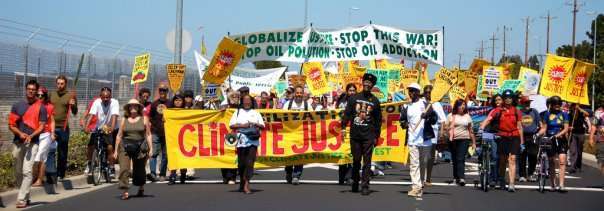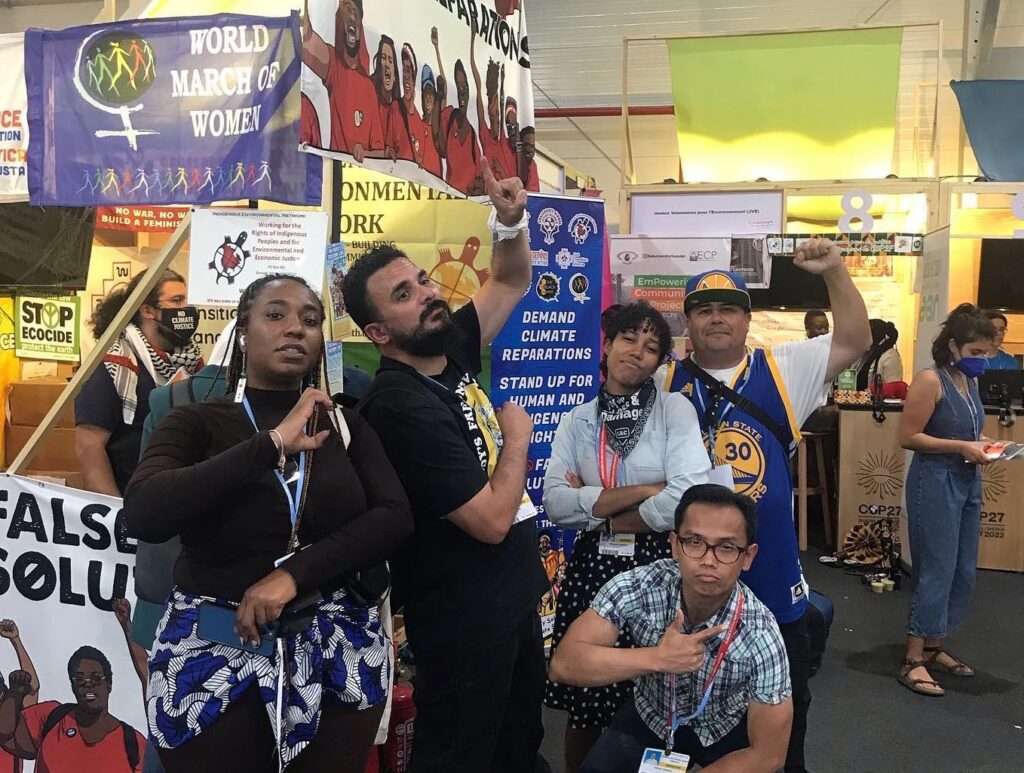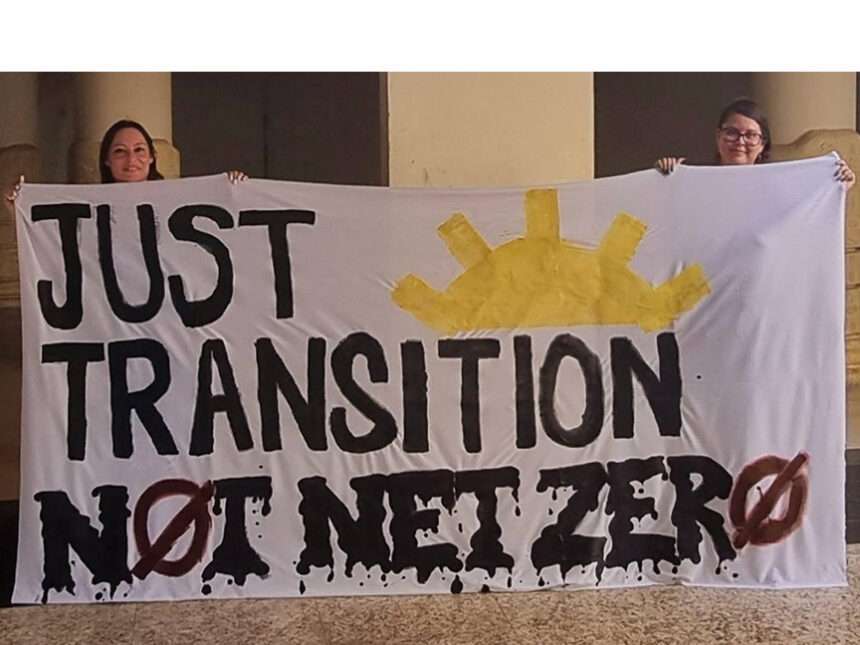Lili Sorum (left) and Paula Muñoz (right) holding a painted banner that reads, “JUST TRANSITION NOT NET ZERO.” Credit: Tyler Norman
This question has been debated amongst grassroots climate and environmental justice (EJ) organizers for the past two decades, ever since the term climate justice was brought to the fore by authors of the Bali Principles of Climate Justice in 2002. I had just started to dip my feet in international policy arenas at the time, and these principles helped me understand the clear and often complex lines delineating difference between EJ principles and campaign compromises made by big green NGOs around market-based, neoliberal policy schemes.
A few years later, in 2009, when allied US funders supported North American EJ groups to play a more active role at COP 15 in Copenhagen, many of us urged our comrades to stay home to align our frontline struggles through mass direct actions targeting corporations driving the climate crisis. Organizing coordinated days of action under the banner of Mobilization for Climate Justice, our efforts began to convene meetings and assemblies that launched the Climate Justice Alliance in subsequent years. While little was achieved at COP 15, by concentrating efforts on our local frontlines of struggle, we were able to shift the narrative needle towards a more justice-centered approach to tackling the crisis, embodied in the action slogan “Systems Change, Not Climate Change.”

Mobilization for Climate Justice mass action at Chevron Refinery. Credit: Brooke Anderson
While there never has been much clarity of purpose or design in the oft-stated “inside-outside strategy” idea borrowed from the anti-globalization NGOs of the 90s, the theme of naming and shaming neoliberal corporate policy schemes with mass, direct action has continued to shape the debate both inside the UNFCCC and on the streets where we often have to call out more privileged Environmental NGOs for their corporate collusion and compromise.
Reflecting back on the past twenty years of UNFCCC engagement, I believe the street heat we generated at events like the People’s Climate March in 2014 and Jerry Brown’s Global Climate Action Summit in 2018 had far more success at forcing meaningful climate action than the $millions spent on flying thousands of civil society cadre to the UN, only to twiddle their thumbs while waiting in the corridors of the conference of polluters and profiteers for audience with their political puppets. I believe that mass direct action strategy (people power) has been central to leveraging political space and podium for the leadership of Indigenous and EJ frontline communities at the UN. It has been our popular grassroots demands, borne from such direct action that have actually shifted the debate on corporate greenwashing, where dirty energy corporations continue to seek subsidies and loopholes to avoid reducing their pollution loads.
The Inside-Outside Battle of Greenwashing
Ever since the 2015 Paris Agreement ushered in a new era of polluter subsidies, opening the door for the deceptive buzzword “Net Zero Emissions,” philanthro-capitalism has guided NGO climate actions to become increasingly performative, both inside and outside the UN COP process. A cynical view is that our enemies have adopted a strategy that accommodates NGO protests at these events to ensure civil society does not actually disrupt or derail the corporate agenda – where actions shy away from exposing efforts to protect polluter investments. Many have pointed out that such Machiavellian designs included deceiving/misleading grassroots direct action campaigns like XR and Sunrise to adopt corporate greenwash demands like Net Zero.

Climate justice march at COP 26, Glasgow. Credit: The Guardian
So while our movements have made gains in centering the leadership of frontline communities in the broader climate movement since 2014, we have also had to spend much of our time and energy in confronting and educating our allies and big green friends on the range of false corporate scams being brokered through policy arenas like the UNFCCC. And even as we have struggled with such movement alignment, a whole host of new-fangled greenwash programs such as Nature-based Solutions, Bio-energy and Carbon Capture Utilization and Storage (CCUS), have emerged to further distract the UN COP process from meaningful climate action.
This was never more evident than at Sharm El-Sheikh, Egypt, where COP 27 appeared more like a global trade show centered around peddling various market-based climate profiteering schemes and bogus techno-fixes.
COP 27 Carnival of Corporate Climate Scams
While the agenda at COP 26 in Scotland was driven by the global banking sector pushing net zero commitments from investors, COP 27 was opened up as a marketplace for American and European corporations, investors and accounting firms looking to make a buck by peddling their techno-fixes and shady services to poor nations seeking climate adaptation funding. And while some token provisions for funding loss and damage funding were finally (after a decade of unfulfilled promises) made by China, Canada and the EU, these commitments were not without a multitude of strings attached. The biggest corporate greenwashers on-site were a) the nuclear power lobby, with numerous astroturf acolytes in tow – like Nukes for Climate and Youth for Nuclear, who swarmed the event with banners, booths and greenwash memes galore, and b) the more covert but omni-present CCUS lobby that has been set up to provide cover for fossil fuel industry and other dirty energy industries to protect their investments from climate action mandates.
And by muzzling civil society’s permitted actions from naming and shaming such corporate climate criminals and their political shills, the UNFCCC effectively constrained climate NGO groups to organizing performative actions and marches within the conference space, with little to no media coverage or strategic purpose. On the flipside, armed with over 5000 copies of Hoodwinked in the Hothouse, and a small but mighty little booth inside the convention center, It Takes Roots Alliance members – Indigenous Environmental Network, Grassroots Global Justice Alliance, Climate Justice Alliance, La Via Campesina, Indigenous Climate Action, Black Hive Collective, the World March of Women and JTA – were able to engage a much broader swathe of UN delegates, ally NGOs, youth activists, media and even our opponents, than we had ever done before. By engaging, confronting and exposing false corporate schemes and getting copies of Hoodwinked into the hands of delegates from poor nations craving more information, we were able to put the media spotlight on the prevalence of such greenwashing at the UN, forcing UN Secretary General Antonio Guterres to concede that “We must have zero tolerance for net zero greenwashing…..”

It Takes Roots organizers at COP 27, Sharm El-Sheikh. Credit: Ananda Lee Tan
The Path Forward
During COP 27, It Takes Roots met with movement allies from the African Climate Justice Collective, La Via Campesina and various Indigenous Peoples’ movements from around the world, and there was general consensus acknowledging that our grassroots movements need to swiftly adapt to the current policy battlefield, prioritizing building the political power of our bases to push back against disaster capitalism, while cultivating alternative political fora where we can advance real, place-based solutions led by the self-determination of communities and workers. We agreed to seek a “long-haul” strategy for engaging the UNFCCC, acknowledging it has taken us over 20 years to delineate neoliberal disaster capitalism proposals from the real needs of frontline communities. And in order for our Just Transition strategies and pathways to persevere, we need to keep confronting the climate profiteers at these policy spaces because the consequences will be dire if we don’t. So, while adapting our work to prioritize local political arenas where we can achieve the most transformative change, we must get better at disrupting and pushing back on the corporate capture of the UN.
For more details and technical background information on COP 27, here are a couple of posts from our closest allies worth reading:
- The Greenwashing Scam Behind COP 27’s Flop – exposing the role of Carbon Capture and Storage in greenwashing various fossil fuel and dirty energy industries, by Basav Sen of the Institute for Policy Studies
- Critique of COP 27 and Article 6 – looking at elements of the Paris Agreement that continued to advance a pollution trading framework, by Alberto Saldamando of the Indigenous Environmental Network

